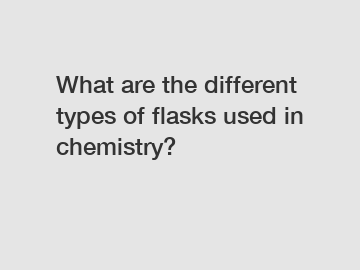What are the different types of flasks used in chemistry?
Chemistry, the captivating realm where countless microscopic interactions manifest macroscopic changes, involves a wide range of instruments to facilitate experimental exploration. Among these diverse tools, flasks play a vital role, serving as vessels that hold and manipulate substances. In this comprehensive guide, we will delve into the realm of chemistry flasks, shedding light on their various types, functions, and contributions to scientific discoveries. Whether you are a curious student, a passionate researcher, or an avid science enthusiast, join us on this fascinating journey through the world of chemical flasks.
1. Erlenmeyer Flask (Conical Flask):
One of the most iconic flasks in chemistry is the Erlenmeyer flask, also known as the conical flask. This flask boasts a narrow neck and broad conical base, allowing for efficient swirling and mixing of liquids. Due to its shape, the Erlenmeyer flask is particularly useful when undertaking reactions that involve the evaporation of solvents, as it minimizes the risk of spills. Its versatility makes it an indispensable tool in laboratories worldwide, ranging from titrations to culturing microorganisms.

2. Round-Bottom Flask:
A common sight in laboratories, the round-bottom flask is recognized for its characteristic spherical base. This flask excels in applications that require boiling, condensing, or distilling substances. Its shape maximizes the surface area available for heating and evaporation, enhancing the efficiency of these processes. To complement its functionality, round-bottom flasks often come equipped with ground glass joints, allowing for easy attachment to other lab apparatus.
3. Florence Flask (Boiling Flask):
Named after the picturesque city of Florence in Italy, the Florence flask, or boiling flask, features a bulbed body and a long neck. Its design aims to evenly distribute heat during boiling and facilitates the refilling process. Typically utilized in distillations or refluxing experiments, this flask enables scientists to observe critical changes in the substances being examined while ensuring safety and precision.
4. Volumetric Flask:
When precise measurements are paramount, the volumetric flask takes center stage. This flask boasts a round or flat-bottomed design, with a long narrow neck and a precise graduation mark. Widely employed for preparing precise volumetric solutions or stock solutions, the volumetric flask guarantees accurate volume measurements due to its predetermined calibration mark and tight stopper.
5. Filtering Flask (Büchner Flask):
For separation procedures such as filtration, the filtering flask, often referred to as the Büchner flask, proves invaluable. Its conical shape and side-arm make it ideal for housing a Büchner funnel or a simple glass filter funnel, enabling researchers to isolate solids from liquids efficiently. The side-arm attachment allows for enhanced airflow and vacuum-assisted filtration, making it a crucial component in laboratory setups.
6. Dewar Flask:
In the realm of cryogenics, the Dewar flask takes center stage. Designed for the storage and transportation of cryogenic substances, this flask features a double-walled structure with a vacuum-sealed space between the inner and outer walls. By minimizing heat transfer through conduction or radiation, the Dewar flask preserves the low temperatures required for experiments involving liquid nitrogen or other cryogens.
Conclusion:
Within the captivating world of chemistry, flasks play a pivotal role in facilitating myriad experiments and scientific investigations. From the efficiency of the Erlenmeyer flask to the precision of the volumetric flask, each type of flask boasts unique characteristics and applications. By understanding the diverse roles flasks fulfill, scientists can confidently select the appropriate vessel to enhance their research endeavors. As we continue to unlock the mysteries of the universe through chemistry, let us cherish the ever-present companionship of these invaluable flasks.
Are you interested in learning more about tissue culture flask sizes, flask sizes cell culture, erlenmeyer flask used for? Contact us today to secure an expert consultation!

Comments
0